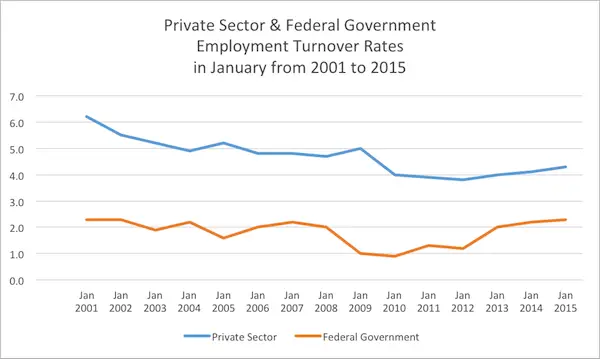You work 1 year or 30 years for the federal government. When you leave, you take your knowledge and experience with you. Does the federal government even notice?
The National Active and Retired Federal Employees Association (NARFE) argues that “America’s most experienced federal employees are leaving the federal workforce at an alarming rate,” but government statistics indicate that the turnover rate for federal employees remains well below the rate in the private sector.
Peaking in January, a month when many federal employees choose to retire, 2.3% of employees left the federal government in the first month of 2015, while in the private sector 4.3% of workers left their jobs. The rate for workers in the leisure and hospitality industry was even greater at 5.9%.
Most federal workers leave government service only due to retirement, death, or layoff. The quit rate is extremely low. In 2014, the quit rate for the federal government never exceeded 0.4% of workers in any month.
Even if few employees leave federal service when compared to other sectors of the economy, is NARFE correct that the loss of institutional knowledge is being lost at an unacceptable rate?
Unfortunately, the current Office of Personnel Management lacks a good handle on who is leaving federal service, why, and what knowledge they take with them.
OPM requires that agencies conduct an annual survey of employees known as the Employee Viewpoint Survey (EVS).
Agencies are required to conduct this survey, but using their results is mostly left to the discretion of individual agencies. From the responses to the surveys themselves, it can be seen that employees are skeptical that survey results influence management decisions.
OPM also encourages agencies to conduct exit interviews with employees leaving the government, but these are not done in a consistent fashion.
Unfortunately, there is little consolidation of the results or systematic follow-up to any of the survey questions.
Moreover, any results obtained quantify only employees’ opinions but do not actually inventory skills, so even if agencies wanted to react to results, there is no quantifiable measure of actual skills walking out the door with the employee.
All the agency knows is a generic set of your job duties as written in your job description. Whether it accurately and totally captures your actual work is problematic.
By 2022, the U.S. Bureau of Labor Statistics predicts that the federal workforce will shrink by 400,000 employees.
Until OPM gets a better handle on the knowledge base of its own workers and quantifies their workers’ skillsets, the costs and benefits incurred by employee turnover in the federal government remains a mystery.
And without that knowledge, agencies cannot improve their performance or even know the cost of losing you.



